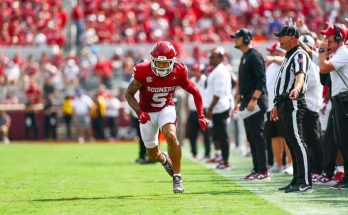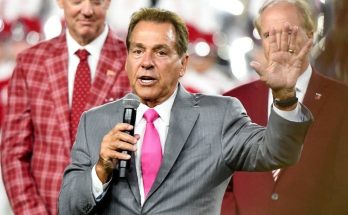The college football recruiting landscape received a seismic jolt this week as the nation’s No. 1 high school prospect, widely regarded as a generational talent, announced his commitment to the Florida Gators. This decision, which came after months of speculation and intense scrutiny from fans, media, and rival programs, is already being called one of the most consequential recruiting victories in recent college football history. What makes the news even more remarkable is that the young athlete chose the Gators over multiple Southeastern Conference (SEC) powerhouses, while also turning down a staggering $150 million Name, Image, and Likeness (NIL) offer that had been structured to entice him to another program. This choice represents a significant moment not only for Florida but for the broader landscape of college athletics, demonstrating that program culture, coaching, and fit can still outweigh enormous financial incentives in the decision-making process of elite prospects.
The player, whose athletic prowess and skill have drawn comparisons to some of the greatest college football stars in history, emerged as the clear frontrunner for the No. 1 ranking during his high school career. Scouts and analysts have lauded his combination of speed, agility, football IQ, and leadership, noting that his skill set is uniquely versatile. Whether it be as a dynamic quarterback capable of orchestrating a high-octane offense, a versatile running back capable of breaking big plays, or a multi-dimensional wide receiver threatening defenses downfield, his potential seems limitless. For Florida, landing this talent is more than just a win on the recruiting trail; it signals a statement of intent. Under the leadership of head coach Billy Napier, the Gators have been steadily rebuilding their program, blending strong recruiting classes with a commitment to player development and a culture-focused approach. This commitment represents a monumental step forward in that vision.
The commitment announcement itself was a highly publicized event. It took place via social media, with the prospect sharing a heartfelt message about the decision-making process, his vision for his future, and his admiration for the coaching staff at Florida. Fans of the program were quick to express their excitement, with social media platforms inundated with messages of support and celebration. Analysts, meanwhile, dissected the implications of the decision, noting that it will not only bolster the Gators’ roster but also reshape recruiting dynamics across the SEC. With elite talent increasingly mobile and NIL deals transforming the economics of college athletics, this commitment underscores the idea that players still weigh program fit, culture, and development opportunities when making these life-changing decisions.
Turning down the $150 million NIL deal was perhaps the most talked-about aspect of the announcement. In an era where collegiate athletes can now legally profit from their name, image, and likeness, the sums being offered to elite prospects have reached unprecedented levels. Rival programs reportedly structured the deal to provide immediate financial security for the player, with endorsement contracts, sponsorship opportunities, and media appearances designed to ensure long-term wealth even before stepping onto an NFL field. That he would choose Florida over such a lucrative offer reflects not only a deep level of confidence in the Gators’ program but also an understanding of the broader picture—one where development, exposure, and team success may ultimately yield greater professional and personal rewards than a single financial windfall. It also suggests a maturing perspective among young athletes, many of whom are navigating the complex balance between short-term financial gain and long-term career strategy in the world of college athletics.
The announcement has significant implications for the SEC, historically the most competitive conference in college football. The league has long been a magnet for elite recruits, with programs such as Alabama, Georgia, LSU, and Texas A&M routinely landing top-tier talent. That Florida, which has been working to reestablish itself as a national powerhouse, could successfully compete for and secure the nation’s top prospect signals a shift in recruiting momentum. For rival programs, this will likely intensify the pressure to maintain their recruiting dominance and further strategize around NIL offers, player development programs, and overall team culture. The ripple effects of this commitment are expected to extend beyond a single class, influencing recruiting battles for years to come as other top-tier prospects weigh Florida’s approach against other SEC heavyweights.
Coaches and analysts have been quick to highlight the leadership and vision of Florida’s staff as a critical factor in the decision. Head coach Billy Napier has been praised for his ability to communicate a clear plan for the program, emphasizing player development, academic success, and competitive excellence. Assistant coaches, who have forged strong relationships with the prospect and his family, also played a pivotal role, creating an environment in which the young athlete felt valued, supported, and understood. In addition to the on-field advantages, Florida’s facilities, academic programs, and recent efforts to cultivate a culture of excellence were repeatedly cited as influences in the decision-making process. This holistic approach appears to have resonated with the prospect, demonstrating that recruiting in the modern era extends far beyond the X’s and O’s and into personal relationships, mentorship, and long-term vision.
From a strategic perspective, landing the nation’s No. 1 recruit has immediate and long-term benefits for the Gators. On the field, the addition of such a dynamic athlete provides a significant upgrade in talent, versatility, and playmaking ability. Whether the team deploys him at quarterback, running back, or wide receiver, his presence alters defensive schemes and opens opportunities for other players to thrive. Off the field, this commitment serves as a powerful recruiting tool. Future prospects may now view Florida as a destination capable of competing with the very best programs in the country, reinforcing the message that the Gators are committed to winning and building a sustainable championship-level program. This kind of momentum can often catalyze a cascade effect, attracting additional high-level recruits in subsequent cycles and strengthening the program’s depth and talent pipeline.
The decision also raises questions and discussions around NIL offers and the broader commercialization of college athletics. Critics of massive NIL deals argue that the escalating financial stakes can distract players from the sport itself and may place undue pressure on young athletes and their families. Others contend that these deals provide much-needed financial opportunity for athletes who dedicate their lives to a sport yet historically receive little monetary compensation. In this context, the prospect’s decision to prioritize program fit and development over immediate financial gain adds a compelling narrative to the ongoing debate. It suggests that while NIL opportunities are significant, they are not the sole determinant in a recruit’s decision-making process, highlighting the enduring value of coaching, team culture, and personal growth.
The media and fan reaction to the announcement has been swift and intense. Social media platforms have been flooded with celebratory posts, GIFs, and highlights, while analysts have debated how this decision will affect the upcoming college football season. Florida’s fanbase, in particular, has embraced the announcement as a symbol of resurgence, providing a much-needed morale boost and a sense of optimism for the program’s future. Rival programs, meanwhile, are carefully analyzing the implications for their own recruiting strategies and roster construction, fully aware that landing the nation’s top talent often signals an edge in the highly competitive world of college football.
Looking ahead, the next steps for Florida’s program will involve integrating the prospect into the team, ensuring he has the support needed to succeed both on and off the field. This includes not only athletic development but also academic guidance, mentorship, and a structured plan for maximizing his exposure to future professional opportunities. For the player, the commitment represents the beginning of a journey, one in which his choice of school will define both his collegiate experience and his path toward a professional career. The story will undoubtedly be closely followed, not only by fans and analysts but by prospective recruits who see the decision as a model for navigating the complex, high-stakes world of college athletics.



